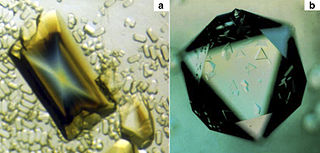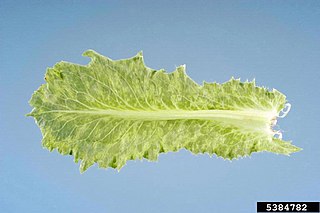External links
- ICTVdB - The Universal Virus Database: Primula mottle virus
- Family Groups - The Baltimore Method Archived 2013-03-30 at the Wayback Machine
| Primula mottle virus (PrMoV) | |
|---|---|
| Virus classification | |
| Group: | Group IV ((+)ssRNA) |
| Family: | |
| Genus: | |
| Species: | Primula mottle virus |
Primula mottle virus (PrMoV) is a plant pathogenic virus of the family Potyviridae.

A satellite is a subviral agent that depends on the coinfection of a host cell with a helper virus for its replication. Satellites can be divided into two major classes: satellite viruses and satellite nucleic acids. Satellite viruses, which are most commonly associated with plants, are also found in mammals, arthropods, and bacteria. They encode structural proteins to enclose their genetic material, which are therefore distinct from the structural proteins of their helper viruses. Satellite nucleic acids, in contrast, do not encode their own structural proteins, but instead are encapsulated by proteins encoded by their helper viruses. The genomes of satellites range upward from 359 nucleotides in length for satellite tobacco ringspot virus RNA (STobRV).

Tobamovirus is a genus of positive-strand RNA viruses in the family Virgaviridae. Many plants, including tobacco, potato, tomato, and squash, serve as natural hosts. Diseases associated with this genus include: necrotic lesions on leaves. The name Tobamovirus comes from the host and symptoms of the first virus discovered.

Potyvirus is a genus of positive-strand RNA viruses in the family Potyviridae. Plants serve as natural hosts. Like begomoviruses, members of this genus may cause significant losses in agricultural, pastoral, horticultural, and ornamental crops. More than 200 species of aphids spread potyviruses, and most are from the subfamily Aphidinae. The genus contains 190 species and potyviruses account for about thirty percent of all currently known plant viruses.
Andean potato mottle virus (APMoV) is a plant pathogenic virus of the family Comoviridae.
Bean pod mottle virus, or BPMV, is a species of plant pathogenic virus in the family Secoviridae. It is known to infect soybean crops.

Bidens mottle virus (BiMoV) is a pathogenic plant virus in the plant virus family Potyviridae. BiMoV is a flexuous filamentous particle, 720 nm long, and belongs to the Potyviridae genus Potyvirus. Like other viruses in this genus, Bidens mottle virus is transmitted both mechanically by sap and by aphids in a stylet-borne fashion.
Carnation vein mottle virus is a plant pathogenic virus of the family Potyviridae.
Cocksfoot mottle virus (CfMV) is a pathogenic plant virus belonging to the genus Sobemovirus. The virus appears in southern and central England. It is transmitted by beetles Lema melanopa and Lema lichenis and is common in crops of cocksfoot and cocksfoot/legume mixtures.

Cowpea mild mottle virus (CPMMV) is a plant pathogenic virus of the family Betaflexiviridae that infects yardlong beans, soybeans and peanuts. It is transmitted by whiteflies that feed on the underside of plant leaves. Symptoms of infection include leaf malformation and mosaic, or spotted, patterns on the leaves. According to the Handbook of Plant Virus Diseases, the pathogen is found in "China, India, Indonesia, Ivory Coast, Nigeria, Thailand, Philippines, Papua New Guinea [and] Sudan".
Elm mottle virus (EMoV) is a species of plant pathogenic virus in the family Bromoviridae.

Peanut mottle virus(PeMoV) is a pathogenic plant virus of the family Potyviridae. As with other members of this virus family, PeMoV is a flexuous filamentous virus with particles 740–750 nm long. It is transmitted by several species of aphids and by mechanical inoculation. It was first given its name in 1965 when it was isolated from peanuts (Arachis hypogaea) in Georgia, United States. The virus was found to be seed transmitted in its host.
Soybean chlorotic mottle virus (SbCMV) is a plant pathogenic virus of the family Caulimoviridae, genus Soymovirus.
Strawberry mottle virus (SMV) is a pathogenic plant virus in Secoviridae, a family of plant-infecting picornaviruses. It is not yet assigned to a genus. Virions are isometric, approximately 28 nm in diameter, and contain two RNA strands (RNA1 and RNA2) equal to about 12,600 nucleotides in length. The polyprotein of RNA1 contains regions identified as helicase, protease, RNA-dependent RNA polymerase and a viral genome-linked protein while RNA2 shows similarities to the large coat protein domain of the Satsuma dwarf virus.

Ilarvirus is a genus of positive-strand RNA viruses in the family Bromoviridae. Plants serve as natural hosts. There are 22 species in this genus.
Umbravirus is a genus of plant viruses assigned to the family Tombusviridae. The genus has 11 species.

Mottle is a pattern of irregular marks, spots, streaks, blotches or patches of different shades or colours. It is commonly used to describe the surface of plants or the skin of animals. In plants, mottling usually consists of yellowish spots on plants, and is usually a sign of disease or malnutrition. Many plant viruses cause mottling, some examples being:

Aspiviridae, formerly Ophioviridae, is a family of segmented negative-strand RNA viruses which infect plants. Member viruses are characterized by an elongated and highly filamentous and flexible nucleocapsid with helical symmetry. It is a monotypic taxon containing only one genus, Ophiovirus. Aspiviridae is also the only family in the order Serpentovirales, which in turn is the only order in the class Milneviricetes.

Emaravirus is a genus of negative-strand RNA viruses which infect plants. The plant virus group is the sole genus in the family Fimoviridae. The genus has 21 species.

Badnavirus is a genus of viruses, in the family Caulimoviridae order Ortervirales. Plants serve as natural hosts. There are 67 species in this genus. Diseases associated with this genus include: CSSV: leaf chlorosis, root necrosis, red vein banding in young leaves, small mottled pods, and stem/root swelling followed by die-back. Infection decreases yield by 25% within one year, 50% within two years and usually kills trees within 3–4 years.

Comovirus is a genus of viruses in the order Picornavirales, in the family Secoviridae, in the subfamily Comovirinae. Plants serve as natural hosts. There are 15 species in this genus.